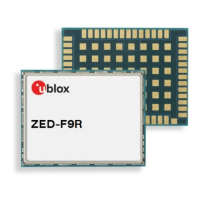ZED-F9R - Application note
UBX-22035176 - R01 Contents Page 13 of 30
C1-Public
Finally, attach the receiver rigidly to the vehicle’s frame. meaning that it must not be able to move
relative to the vehicle. This also means that the receiver must not be attached to any part of the
vehicle that is able to move. Any movement and excessive vibration will be detrimental to the
navigation performance.
3.2 Mounting the antenna
Find a suitable location for the antenna. The antenna must be placed so that is has a clear view of the
sky. For best performance, place the antenna as close to the receiver as possible.
If the antenna is an active patch antenna such as the u-blox ANN-MB, it needs a sufficient ground
plane, e.g., a metallic disc with a ~15 cm diameter.
3.3 Connecting cables
Connect all the necessary cables, i.e., power, antenna, serial communication etc. to the receiver. Verify
that the receiver is operational by repeating the procedure in 2.1
Once the serial connection to the receiver is established and verified, the installation part is complete.
3.4 Setting up UART configuration
If you are using UART as the main interface for communication, increase the receiver’s baudrate. The
default baudrate of 38400 may not be fast enough if the receiver is outputting a high number of
messages. This can lead to data loss and even a complete failure in communication.
The recommended baudrate is 115200. This can be configured with CFG-UART1-BAUDRATE. Some
applications may require even higher rates, especially if a higher navigation output rate is enabled.
The utilization of the receiver’s communication ports can be monitored with the UBX-MON-COMMS,
UBX-MON-TXBUF and UBX-MON-RXBUF messages.

